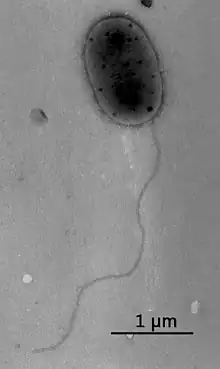Methylobacterium
| Methylobacterium | |
|---|---|
 | |
| Methylobacterium jeotgali strain S2R03-9T | |
| Scientific classification | |
| Kingdom: | Bacteria |
| Phylum: | |
| Class: | |
| Order: | |
| Family: | |
| Genus: | Methylobacterium Patt et al. 1976 (Approved Lists 1980) |
| Type species | |
| Methylobacterium organophilum[1] | |
| Species | |
|
See text. | |
Methylobacterium is a genus of Hyphomicrobiales.[2]
As well as its normal habitats in soil and water, Methylobacterium has also been identified as a contaminant of DNA extraction kit reagents, which may lead to its erroneous appearance in microbiota or metagenomic datasets.[3] In March 2021, a new species, tentatively named Methylobacterium ajmalii, associated with three new strains, designated IF7SW-B2T, IIF1SW-B5, and IIF4SW-B5, were reported to have been discovered, for the first time, on the International Space Station.[4][5]
Natural genetic transformation
Natural genetic transformation in bacteria is a process involving transfer of DNA from one cell to another through the intervening medium, and the integration of the donor sequence into the recipient genome by homologous recombination. Methylobacterium organophilum cells are able to undergo genetic transformation and become competent for DNA uptake near the end of the exponential growth phase.[6]
Species
Methylobacterium comprises the following species:[7]
- Methylobacterium adhaesivum Gallego et al. 2006
- Methylobacterium aerolatum Weon et al. 2008
- "Methylobacterium ajmalii" Bijlani et al. 2021[8]
- Methylobacterium aquaticum Gallego et al. 2005
- Methylobacterium brachiatum Kato et al. 2008
- Methylobacterium brachythecii Tani and Sahin 2013
- Methylobacterium bullatum Hoppe et al. 2012
- Methylobacterium cerastii Wellner et al. 2012
- Methylobacterium crusticola Jia et al. 2020
- Methylobacterium currus Park et al. 2018
- Methylobacterium dankookense Lee et al. 2013
- Methylobacterium durans Kim et al. 2020
- Methylobacterium frigidaeris Lee and Jeon 2018
- Methylobacterium fujisawaense Green et al. 1988
- "Methylobacterium funariae" Schauer and Kutschera 2011
- Methylobacterium gnaphalii Tani et al. 2012
- Methylobacterium goesingense Idris et al. 2012
- Methylobacterium gossipiicola Madhaiyan et al. 2012
- Methylobacterium gregans Kato et al. 2008
- Methylobacterium haplocladii Tani and Sahin 2013
- Methylobacterium hispanicum Gallego et al. 2005
- "Methylobacterium indicum" Chaudhry et al. 2016
- Methylobacterium iners Weon et al. 2008
- Methylobacterium isbiliense Gallego et al. 2005
- Methylobacterium jeotgali Aslam et al. 2007
- Methylobacterium komagatae Kato et al. 2008
- Methylobacterium longum Knief et al. 2012
- Methylobacterium marchantiae Schauer et al. 2011
- Methylobacterium mesophilicum (Austin and Goodfellow 1979) Green and Bousfield 1983
- Methylobacterium nodulans Jourand et al. 2004
- Methylobacterium nonmethylotrophicum Feng et al. 2020
- Methylobacterium organophilum Patt et al. 1976 (Approved Lists 1980)
- Methylobacterium oryzae Madhaiyan et al. 2007
- Methylobacterium oryzihabitans Chen et al. 2019
- Methylobacterium oxalidis Tani et al. 2012
- Methylobacterium persicinum Kato et al. 2008
- Methylobacterium phyllosphaerae Madhaiyan et al. 2009
- Methylobacterium phyllostachyos Madhaiyan and Poonguzhali 2014
- "Methylobacterium planium" Jiang et al. 2020
- Methylobacterium platani Kang et al. 2007
- Methylobacterium pseudosasicola Madhaiyan and Poonguzhali 2014
- Methylobacterium radiotolerans corrig. (Ito and Iizuka 1971) Green and Bousfield 1983
- Methylobacterium segetis Ten et al. 2020
- Methylobacterium soli Cao et al. 2013
- Methylobacterium symbioticum Pascual et al. 2021
- Methylobacterium tardum Kato et al. 2008
- Methylobacterium tarhaniae Veyisoglu et al. 2013
- "Methylobacterium terrae" Kim et al. 2019
- Methylobacterium terricola Kim et al. 2020
- Methylobacterium thuringiense Wellner et al. 2013
- Methylobacterium trifolii Wellner et al. 2013
- Methylobacterium variabile Gallego et al. 2005
References
- ↑ Parte, A.C. "Methylobacterium". LPSN.
- ↑ Garrity, George M.; Brenner, Don J.; Krieg, Noel R.; Staley, James T. (eds.) (2005). Bergey's Manual of Systematic Bacteriology, Volume Two: The Proteobacteria, Part C: The Alpha-, Beta-, Delta-, and Epsilonproteobacteria. New York, New York: Springer. ISBN 978-0-387-24145-6.
- ↑ Salter, S; Cox, M; Turek, E; Calus, S; Cookson, W; Moffatt, M; Turner, P; Parkhill, J; Loman, N; Walker, A (2014). "Reagent contamination can critically impact sequence-based microbiome analyses". bioRxiv 10.1101/007187.
- ↑ Bowler, Jacinta (16 March 2021). "Microbes Unknown to Science Discovered on The International Space Station". ScienceAlert. Retrieved 16 March 2021.
- ↑ Rogers, Adam (April 5, 2021). "Sneaky New Bacteria on the ISS Could Build a Future on Mars". Wired.
One species, found on a HEPA filter in the station’s life-support system, was a garden-variety (literally!) Methylobacterium rhodesianum. But three samples—from a surface near the materials research rack, a wall near the “cupola” of windows, and the astronauts' dining table—were something new.
- ↑ O'Connor M, Wopat A, Hanson RS (1977). "Genetic transformation in Methylobacterium organophilum". J. Gen. Microbiol. 98 (1): 265–72. doi:10.1099/00221287-98-1-265. PMID 401866.
- ↑ Euzéby JP, Parte AC. "Methylobacteriaceae". List of Prokaryotic names with Standing in Nomenclature (LPSN). Retrieved May 22, 2021.
{{cite web}}: CS1 maint: uses authors parameter (link) - ↑ Bijlani S, Singh NK, Eedara VVR, Podile AR, Mason CE, Wang CCC, Venkateswaran K. (2021). "Methylobacterium ajmalii sp. nov., Isolated From the International Space Station". Front Microbiol. 12: 639396. doi:10.3389/fmicb.2021.639396. PMC 8005752. PMID 33790880.
{{cite journal}}: CS1 maint: uses authors parameter (link)
External links